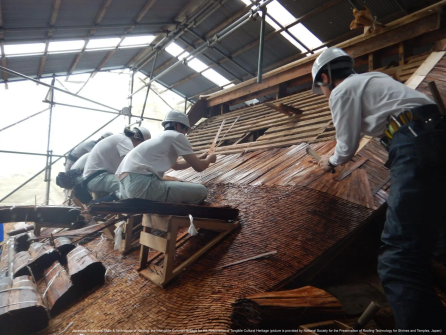18th International Training Course (ITC) on Disaster Risk Management of Cultural Heritage, Ritsumeikan University in collaboration with ICCROM
Dates and Time
- Online – 29 Jul to 16 Aug 2024, 8:00–10:30 (CET/Summer), 15:00–17:30 (JST)
- Onsite – 30 Aug to 13 Sep 2024, 9:00–18:00 (JST)
Background and Objectives of the Course
The International Training Course on Disaster Risk Management of Cultural Heritage follows up on the recommendations adopted at the Special Thematic Session on Risk Management for Cultural Heritage held at UN-WCDR (World Conference on Disaster Reduction) in January 2005 in Kobe, Hyogo, Japan. One of these recommendations advocated the need for the academic community to develop scientific research, education and training programs safeguarding cultural heritage, in both its tangible and intangible manifestations, from the perspective of disaster risk management.
The importance of strengthening knowledge, innovation and education to build a culture of disaster prevention at World Heritage properties was reiterated by the World Heritage Committee at its 30th session (Vilnius, Lithuania, July 2006). To date, 193 professionals from 75 countries have been trained through this annual course.
The course's main objective is to provide theoretical and practical knowledge on the various aspects of cultural heritage disaster risk management.
Please refer to the following link: ITC Core Programme page
Subtheme of ITC 2024
Linking tangible and intangible cultural heritage for disaster risk management
Disaster risk management of cultural heritage is a multifaceted endeavour involving tangible and intangible elements. Tangible elements include historic buildings, sites and objects that constitute cultural heritage, while intangible elements encompass the traditional knowledge activities, rituals and cultural practices associated with them. Understanding the link between these two dimensions is crucial for effective disaster mitigation, preparedness, response and recovery efforts.
Protecting tangible heritage alone is insufficient without considering the associated intangible aspects. Traditional knowledge, activities, rituals and community practices are invaluable resources for building resilience and coping mechanisms in the face of disasters. They provide communities with the tools and strategies necessary to mitigate risks, adapt to changing circumstances and recover from the impact of disasters.
In 2020, the Intangible Cultural Heritage (ICH) “Traditional Skills, Techniques and Knowledge for the Conservation and Transmission of Wooden Architecture in Japan” was inscribed on the Representative List of the Intangible Cultural Heritage of Humanity.
This is a great example that addresses ICH's contribution to the sustainability of tangible cultural heritage through 17 different skills, such as traditional woodworking techniques, decoration of traditional structures and restoration skills of traditional buildings. These are important skills for reducing the risks to cultural heritage from disasters caused by various natural and human-induced hazards.
Therefore, this year’s ITC will focus on the strategies, tools, and methodologies that reinforce the link between the tangible and the intangible dimensions of disaster risk management of cultural heritage. These include identifying values, vulnerabilities, risks and measures for mitigation, preparedness, response and recovery. In the face of frequently occurring disasters that have caused wide-ranging impacts on peoples' lives, livelihoods and cultural heritage, communities worldwide have developed a rich wealth of traditional and indigenous knowledge that can contribute to disaster risk management. These knowledge systems also embody inherent linkages between tangible and intangible dimensions that should be incorporated into disaster risk management plans for cultural heritage sites and museums. Various disaster risk reduction measures based on traditional and indigenous knowledge developed in response to local communal, geographical, climatic and social characteristics in the Japanese context and in other parts of the world will be introduced to the participants during this interdisciplinary training.
Methodology
This year’s course will be conducted in hybrid mode and will include online and on-site components. These will include thematic lectures, workshops, site visits and fieldwork by Japanese and international experts.
- The online part will be conducted over three weeks. Each week, there will be three live online sessions, including one mentoring session for participants' case study projects.
- The on-site part will be conducted over two weeks. It is focused on on-site visits and field exercises.
- Participants will select one cultural heritage site or institution from their respective countries. They will develop disaster risk management plans during the course, which will be presented during the final presentation.
Participants
The participants will be made up of a maximum of 15 professionals from all parts of the world working in the fields of cultural heritage conservation and disaster risk management.
Working Language
English
Course Fee
Free
Travel, Accommodation and Living Expenses
Participants will be responsible for their own round-trip travel costs to and from Kyoto.
Most of the costs of running the course will be covered by ITC, but participants will be charged approximately 350 000 yen (USD 2 350) to cover the cost of accommodation, lunches and field trips. All participants will stay at the hotel arranged by ITC.
Candidates are strongly encouraged to seek financial support from government institutions, employers and funding agencies. In cases of proven financial need and depending on the availability of funding from external sources at the time of the course, a limited number of partial scholarships may be granted.
What do participants receive after successfully completing the course?
- Course completion certificate
- Publishing online proceedings of ITC 2024 with DRM plans of the Case Study Project prepared by each participant during the course
- Posters based on DRM plans of case study projects prepared during the course will be uploaded on the websites of R-DMUCH and ICCROM
Application Requirements
ITC2024 Guidelines for Application (PDF)
ITC2024 Application Form (Word file)
Application Details
Apply by Friday, 5 April 2024 (3:59pm – CET /11:59pm – JST )
Please submit your application form in a Word file
Submission address: r-itc@st.ritsumei.ac.jp

